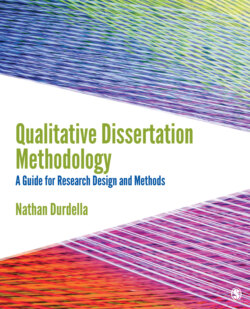Читать книгу Qualitative Dissertation Methodology - Nathan Durdella - Страница 9
На сайте Литреса книга снята с продажи.
Organization of Qualitative Dissertation Methodology
ОглавлениеQualitative Dissertation Methodology: A Guide for Research Design and Methods generally mirrors how students develop a qualitative methodological framework for their dissertations. That is to say, the organization follows the work that students do as they write the methodology chapter: from the activities that help students conceptualize researchable dissertation problems and questions to the tasks that involve forming a methodological framework, including strategies to sample site(s) and participants and approaches to instrumentation, data collection, data analysis, interpretation, and mitigation of researcher effects. This approach will likely be natural to students and their instructors or advisors as the progression of the book parallels the developing of their collaborative dissertation research work. While dissertation research—like social science research more broadly—does not follow a linear pattern from beginning to end, a more recursive and iterative process still requires specific steps that mark movement in a research project. For example, research problems emerge from evaluating, synthesizing, and summarizing areas of the literature most closely aligned with studies’ topics. Similarly, researchers tend to develop research problems (and purposes and questions) before they consider the selection of data collection instruments and procedures—some details need to be settled before others. On a smaller scale, researchers tend to identify sampling strategies before they describe steps and instruments to recruit and select participants at research site(s). Likewise, researchers usually discuss instrumentation and the tools that they plan to use for data collection, after which they contemplate data collection strategies and specific tasks to complete in the field to gather information. Of course, these events do not unfold quite so clearly—they are a bit murkier, a bit messier, and often transpire side-by-side.
Given this general approach to the conduct of social science research, a key feature of Qualitative Dissertation Methodology: A Guide for Research Design and Methods is the organization of the book into three parts: precursors to the methodology chapter, the methodology chapter, and transition to work after the methodology chapter. In reality, students may work on a methodological framework as they are still negotiating participant groups or research sites, interview questions, or analytical techniques, but the development of their methodology chapter generally follows decisions that they make earlier in the research process. While a bit artificially mapped out here, these three parts tend to delineate how they progress through their studies. In the broadest sense, what I mean by what work happens before, during, and after the development of a methodology chapter can be delineated as follows:
Part 1: “Preparing for Methodological Work” lays the groundwork for writing a methodological framework, guiding foundational work that frequently precedes and parallels the chapter’s development. The outcomes for the first part of the book include (a) visualizing the methodology chapter development and conceptualizing the methodological framework for a dissertation study, (b) performing tasks to complete prior to or near the start of writing the bulk of a methodology chapter—including discussing methodological details of a study with a dissertation chair and/or committee—and (c) articulating a section-by-section plan to complete a methodology chapter.
Part 2: “Developing a Methodology Chapter” forms an outline within which students can develop their dissertation methodology chapters. As the foundation of a methodological framework, each chapter focuses on a section for chapter development, treating key concepts of qualitative research design and methods and the application of social science research principles to dissertation contexts. The outcomes for the second part of the book include (a) designing an approach to gathering information through a qualitative research tradition; (b) developing strategies to sample research site(s) and participants—including recruitment and selection procedures; (c) drafting data collection instruments for general tools used in naturalistic inquiry: personal and group interview protocols, observation guides and field notes template, and structured journal guides; and (d) articulating analytical and interpretive approaches—with a focus on thematic data analysis.
Part 3: “Transitioning to Work After a Methodology Chapter” focuses on the work that usually occurs after (and sometimes during) the development of methodology chapter: human subjects protocols. The major outcome of this part of the book is a draft human subjects toolkit and protocol for use with an institutional review board (IRB). Another outcome of the chapter moves well beyond methodology chapter development and into activities that take place during and after data collection: a tentative plan to present results from data analysis. I cover this topic here because one of the concerns that I frequently field from former students—now in their third year or later in the doctoral programs—is how to most effectively approach data analysis and results write-up. In this case, anticipating the analytical and interpretive process a bit seems to support a plan to do so in the methodology chapter.
